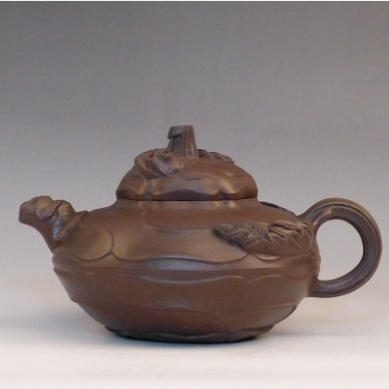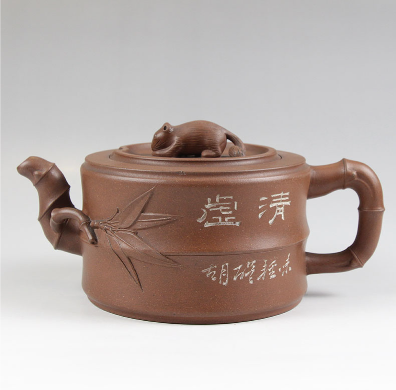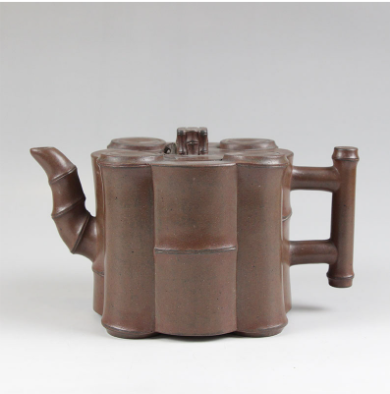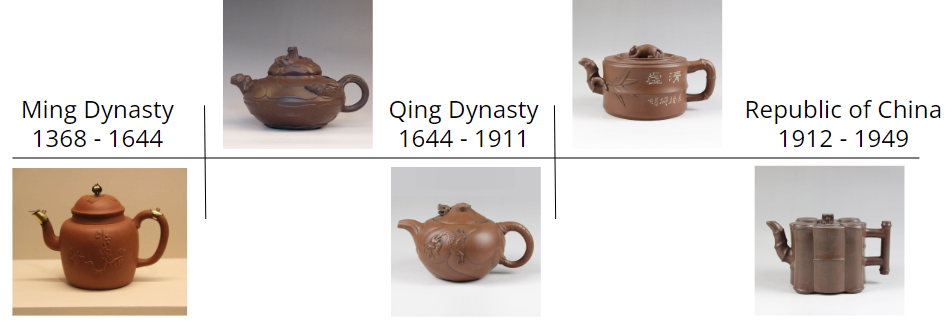Overview
Yixing teapots also known as Zisha teapots are a style of teapot made from zisha clay and are left unglazed. They are from Yixing, a city in China in a hilly area abundant with clay and tea. Zisha clay is found on Huanglongshan Mountain and is a high quality clay for teapots. Once excavated the clay goes through many steps including; weathering, tedding and purification, proportioning, pulverizing, staleness, and clay refining. After passing some tests the clay cannot be used for at least six months. Zisha clay can be split into three different types; purple, red, and green. Most teapots are made with purple clay which has a high iron content and after fired is usually a purple-brown color. Red clay is the second most used and is a bright red, vermilion color after firing. The green clay is scarce and harder to fire so it is mainly used as slip, which is a watery clay mixture used to decorate pots. After firing it is a yellow-green color. The tools for making Yixing teapots are usually made of bamboo, wood, ox-horn, and metal, with only a few being made of plastic.
Yixing teapots were developed in the Ming Dynasty, and were made popular by Gong Chun who had been working under monks who used the clay for their teapots. At this time smaller teapots were becoming more popular, rather than large pots over fire since you could use fewer leaves therefore higher quality leaves. Gong Chun developed two lines of design; the geometric style and the appliqué style. The geometric style looks like older brass teapots and is curved, they have little to no decoration on them and occasionally have poetic phrases on them. The appliqué style or applied style often uses animals and nature, some common elements are branches, leaves, flowers, and fruit. After Gong Chun came Shi Dabin who developed the previous styles further and created the square style. These pots have often been looked over as people are more interested in the glazed teapots like the blue and white porcelains. I will be looking at five pots, one from the Ming Dynasty, two from the Qing Dynasty and two from the Republic of China.
Teapot 1: Stoneware Teapot

Material: Unknown Size: Unknown
Period: Ming Dynasty 1627,
Location: Yixing, China
Source: https://picryl.com/media/stoneware-teapot-yixing-ming-1627-9847277935-125969
Credit: National Museum of China
This is the earliest teapot out of the five, it is from the Ming Dynasty and is a geometric style. This pot also has metal accents which is very unique as throughout my research this is the only one I’ve seen with that. This could be because the potter wanted to show the history of brass teapots that the geometric style is based off of. On the body of the pot there is a flowering branch, as well as some flowers on the lid, this reminds me of appliqué style. The potter could have been experimenting by mixing the two styles. The material is unknown but to me it looks like red clay as all the other pots are purple clay and they are darker while this pot is a bright red-orange.
Teapot 2: Fengjuan Sunflower Pot

Material: Purple Clay Size: Unknown
Period: Qing Dynasty
Location: Yixing, China
Source: https://www.yxtcbwg.com/pc/#/collection/collectDetail?id=70
Credit: China Yixing Ceramic Museum
This teapot is in the appliqué style and has lots of nature. On the body and lid there are sunflower leaves “blowing” around and the handles look like stems. The uneven texture and swirls could possibly symbolize the wind. Sunflowers symbolize longevity and vitality which are also terms associated with tea.
Teapot 3: Fish Transforms into Dragon Pot

Material: Purple Clay Size: 11×7.8cm
Period: Late Qing Dynasty
Location: Yixing, China
Source: https://www.yxtcbwg.com/pc/#/collection/collectDetail?id=37
Credit: China Yixing Ceramic Museum
This teapot is also in the appliqué style with nature and animals. The swirly design is supposed to look like clouds with a dragon flying through them. There is also a dragon head on the lid. On the other side which I cannot find a good picture of there is a carp. The handle also has scales on it and both dragons and fish have scales. This pot tells the story of a little fish transforming into a large powerful dragon. This could be meant to empower the owner or user. Another note is that the dragon is one of the Chinese zodiacs so there could be inspiration from that.
Teapot 4: Bamboo Rat Pot

Material: Purple Clay Size: Unknown
Period: Republic of China
Location: Yixing, China
Source: https://www.yxtcbwg.com/pc/#/collection/collectDetail?id=85
Credit: China Yixing Ceramic Museum
This teapot looks like appliqué style mixed with square style. The shape is inspired by bamboo, and the handle and spout look like bamboo sticks. There is also a small bamboo twig coming out of the spout. On the body is writing, I am not sure what it says there is no translation on the website. On the lid is a baby rat as a handle. The rat is another one of the Chinese zodiacs and symbolizes wisdom and prosperity. This could be because the pot was made for a wealthy patron or maybe they were born in the year of the rat.
Teapot 5: Five Bamboo Pots

Material: Purple Clay Size: Unknown
Period: Republic of China
Location: Yixing, China
Source: https://www.yxtcbwg.com/pc/#/collection/collectDetail?id=82
Credit: China Yixing Ceramic Museum
This teapot is titled “Five Bamboo Pots” on the museum website but it does not say whether there are five pots. It is in the square style and is meant to look like bamboo. Bamboo symbolizes a lot such as integrity, gracefulness, and longevity. These characteristics, especially longevity can relate to tea as it is said that tea can help delay aging.
Timeline

Looking at all of the pots in a timeline you can see the evolution of the designs. They start off looking more round and like the geometric style. The first pot also looks taller and is most likely red clay whereas the others are shorter and wider and are made of purple clay. In the middle of the timeline there are more appliqué style pots and finally towards the end they are more square style. Although, overall there has not been any major changes in these pots, the unglazed clay makes them distinguishable from other pots and they stand out as a connected group.
Why Yixing Teapots are Special
Yixing teapots are left unglazed as the clay is said to impart a flavor in the tea and make very pure tea. These pots are used with teacups which can also be made of zisha clay. Before the tea is made the pot is warmed by having hot water poured over it. Then to make the tea instead of putting the pot directly over a fire the leaves are added and hot water is poured into it. According to Lim Kean Siew, a tea connoisseur and collector of Yixing pots, each pot has an affinity for a certain tea. This could be any tea; black, green, or oolong, but you need to find the tea that your pot has an affinity to. When a pot is used with the correct tea it will develop a shine and will be a brighter color. When the wrong tea is used the pot will become dry and dull. Having the correct pot is important since when it is used and the tea is steeped correctly the tea will have three stages. The first is xiang which is the fragrance, this includes how it smells before drinking and the fragrance within the mouth. The second is wei which is the first flavor on the tongue, it can be stronger or weaker depending on the pot. With the wrong pot it may not even be present. The final stage is yun which is the aftertaste, the length and persistence is indicative of how suitable the teapot was for the particular tea. It is important to sip slowly to sense the full flavors and for yun to develop. Overall Yixing teapots are very unique and have important qualities that other teapots do not have.
Bibliography
Lim, Kean Siew. 2001. The Beauty of Chinese Yixing Teapots & the Finer Art of Tea Drinking. Singapore: Times Editions.
Sweet, Marvin. Ceramics Monthly; January 1999, Vol. 47 Issue 1, p66-69, 4p
Ying, Tang. 2015. “Art of the Yixing Zisha Teapot.” Ceramics Technical 21 (1): 64-69.